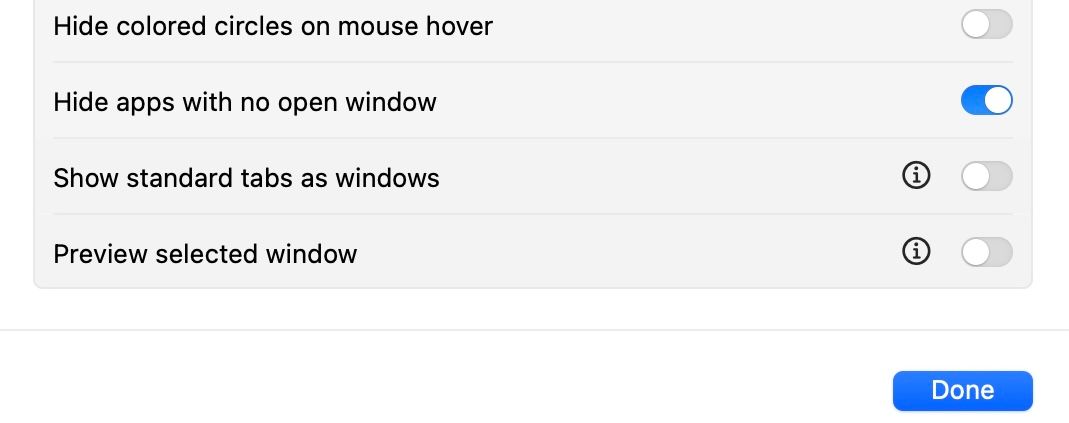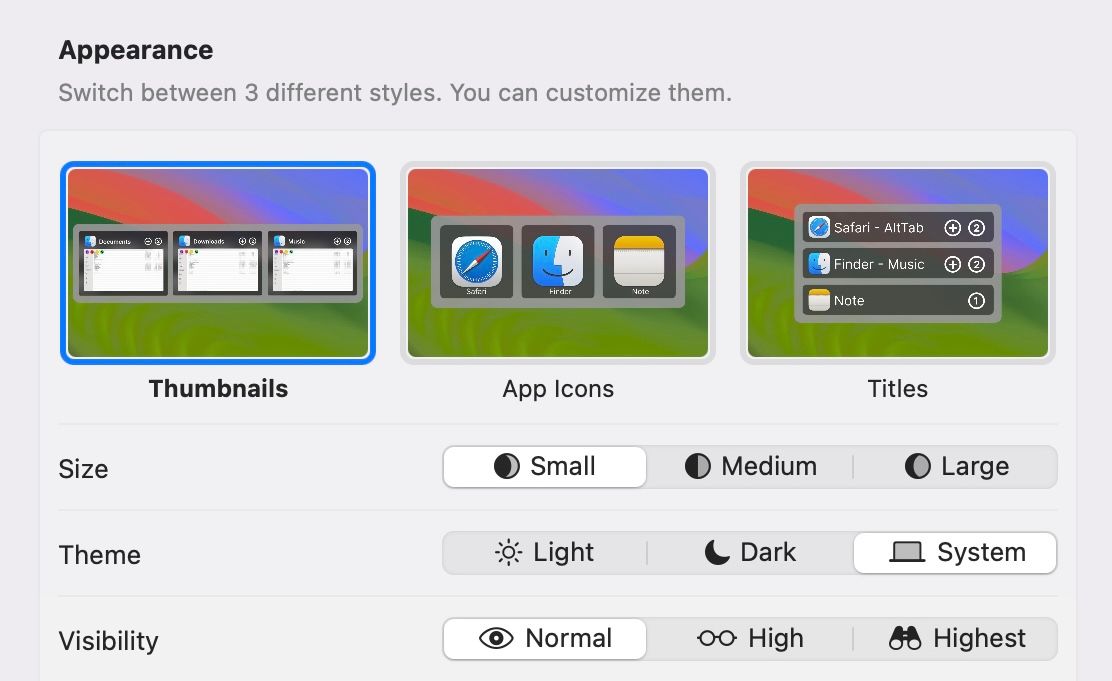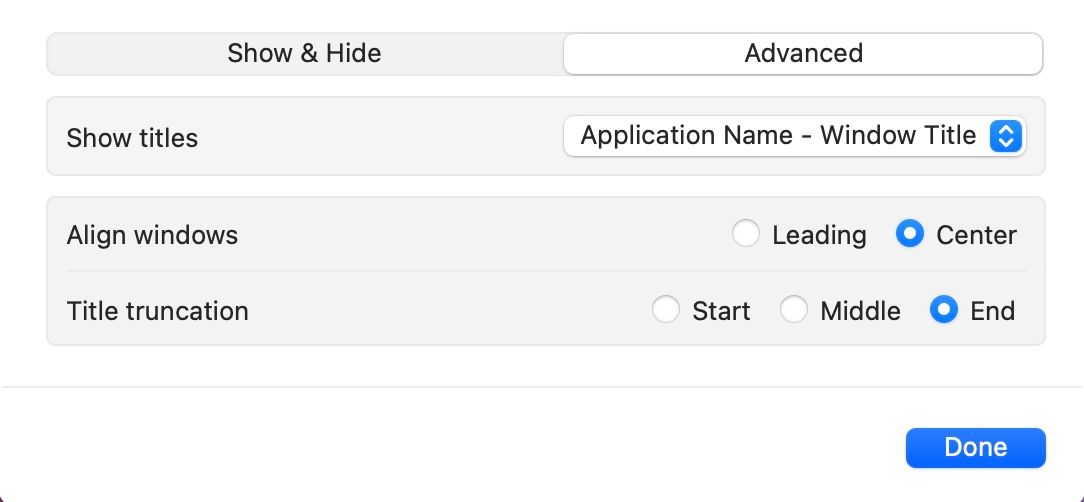To me, Windows outshines macOS in the app and window-switching department thanks to its more refined window switcher. As such, if you’ve switched to a Mac or use Windows as actively as your Mac, you might miss this functionality on your Mac. A small app called AltTab ensures you don’t.
What Is AltTab? And Why Do You Really Need It?
AltTab is a free and open-source app that enhances the app and window-switching experience on your Mac. It works by emulating Windows’ Alt+Tab functionality using a customizable keyboard shortcut. Pressing this shortcut gives you an interactive window switcher with previews of all the currently open apps and their respective windows on your Mac so you can switch between them easily.
Sure, you can use the Command+Tab shortcut to switch between apps on your Mac, but it has a huge limitation. The app switcher it brings up only shows a row of static app icons in the switcher. You don’t get a preview window for each app—as you do on Windows—so you can’t tell what’s happening inside them until you jump in.
Another problem with this approach is that it doesn’t tell you how many windows are open inside each app. As a result, you can’t switch between different windows of the same app. Yes, there’s the Command+` shortcut, which offers similar functionality, but it only works when you have that app in focus. Plus, it, too, doesn’t give you a preview of the windows, so you can’t cycle through and switch between them directly.
Unlike macOS’ native app switcher, AltTab’s window switcher is more visual. While Apple’s version only shows app icons, the AltTab switcher greets you with a preview of all the apps and windows up front, so you don’t have to jump into them to see their content; not to mention, this also enables you to switch between different windows open within the same app.
Aside from simplifying switching between app windows, the AltTab windows switcher lets you perform other actions, too. As such, you can close a window, open it in a full-screen view, minimize it, or even hide or quit it right from the switcher.
How to Use AltTab on Your Mac
AltTab isn’t available on the macOS App Store. To get it on your Mac, head to AltTab’s website, download the latest release, and run it.
Alternatively, if you have Homebrew installed on your Mac, open the macOS Terminal app and run the following command to install AltTab:
brew install --cask alt-tab
Once installed, launch AltTab. It’ll now ask you for the following permissions:
- Accessibility: To let you interact with app windows.
- Screen & System Audio Recording: To show thumbnails of all the open apps or windows in the AltTab window switcher.
Follow the on-screen instructions to grant it access to the requested permissions. Close the AltTab app window since we don’t need it anymore.
With the setup finished, switching between app windows with AltTab is easy. Simply press the Option+Tab shortcut to bring up the AltTab window switcher. Then, with the Option key still pressed, use the Tab key or left and right arrow keys to cycle through all the open apps and windows on your Mac.
Once you’ve selected the app window you want to jump into, release all the keys.
Aside from switching between apps, AltTab also lets you perform other operations on the app windows in the window switcher. For this, you first need to select the app using the Option+Tab shortcut and, then, let go of the Tab key and press any of the following keys based on what you want to do:
- F: Open in full-screen view
- M: Minimize the window
- W: Close the window
- H: Hide or show the app
- Q: Quit the app
Alternatively, you can perform these actions with your Mac’s trackpad or an external mouse. Simply hover over a window in the window switcher while pressing the Option+Tab shortcut and click on the appropriate icon.
How to Customize AltTab’s Appearance and Behavior
AltTab is highly customizable, so you can personalize its appearance and behavior as per your liking. This includes everything from changing the trigger shortcut and customizing the controls to personalizing the appearance and setting up a blacklist to prevent apps from appearing in the AltTab switcher.
You can make any of these changes under AltTab’s preferences. To access them, click the app’s icon in the menu bar and select “Preferences.” Then, based on what you want to configure, head to the appropriate tab and configure the setting as desired.
Set Up a Shortcut to Show Windows From the Active App
By default, AltTab’s window switcher shows windows for all apps currently open on your Mac, including multiple windows open within a single app. If you typically open multiple windows in an app, this behavior would require a few extra key presses since you’ll need to cycle through all app windows to get to the one you want. AltTab saves you trouble by letting you set up a shortcut to cycle through and switch between multiple windows of the same app.
Go to the “Controls” tab in AltTab preferences and click the “Shortcut 2” tab at the top. Here, press the keys next to “Trigger Shortcut” and create a shortcut you prefer. Next, click on the up-down arrow key next to “Show Windows from Applications” and select “Active App.”
You can now press this keyboard shortcut to quickly switch between multiple windows of the same app.
Hide Apps With No Open Windows to Declutter the Switcher
When you access the AltTab window switcher, it even shows apps that don’t have any open windows. However, this isn’t ideal, as it only ends up cluttering the window switcher. Luckily, you can prevent this by hiding apps with no open window.
To do this, in the “Appearance” tab, click the “Customize XYZ Style” button, where XYZ is the name of your preferred style. Then, under the “Show & Hide” tab, toggle on the option for “Hide Apps With No Open Window,” and hit “Done.”
Customize the Preview Style
AltTab packs multiple options to customize the preview style in the window switcher. For instance, you can increase or decrease the size of the thumbnail if the default setting doesn’t look well on your screen, switch between light and dark themes, and adjust the visibility, among other things.
Similarly, if you don’t prefer thumbnails in the window switcher, you may even choose a different style for the preview, though I suggest against doing so as it kind of defeats the purpose of the app. But if you decide to do so, your options include App Icons and Titles.
Based on the style you choose, you can then further customize it by clicking the “Customize XYZ Style” button, where XYZ is the name of the style you choose, and enabling/disabling the different options AltTab offers according to what suits you best. For example, you can hide status icons or app badges for a cleaner view or choose how the windows are titled and positioned in the switcher.
Exclude Apps, Change Animations, Customize Action Shortcuts, and More
Aside from creating a new shortcut and customizing the preview style, you can change a bunch of other things in AltTab according to your preference. For example, you can change the keyboard shortcuts for window actions (quit, hide, and more), enable or disable switcher animations, and increase or decrease the delay of the switcher. You can even exclude apps to prevent them from appearing in the switcher.
AltTab is surely more appealing to those who miss Windows’ Alt+Tab switching on their Macs, but it’s equally beneficial to anyone who works with too many apps at once and is looking to enhance their workflow. The visual and interactive approach to window switching, combined with the ease of switching between them and performing other window actions that it facilitates, makes it a must-have Mac app for most people.










